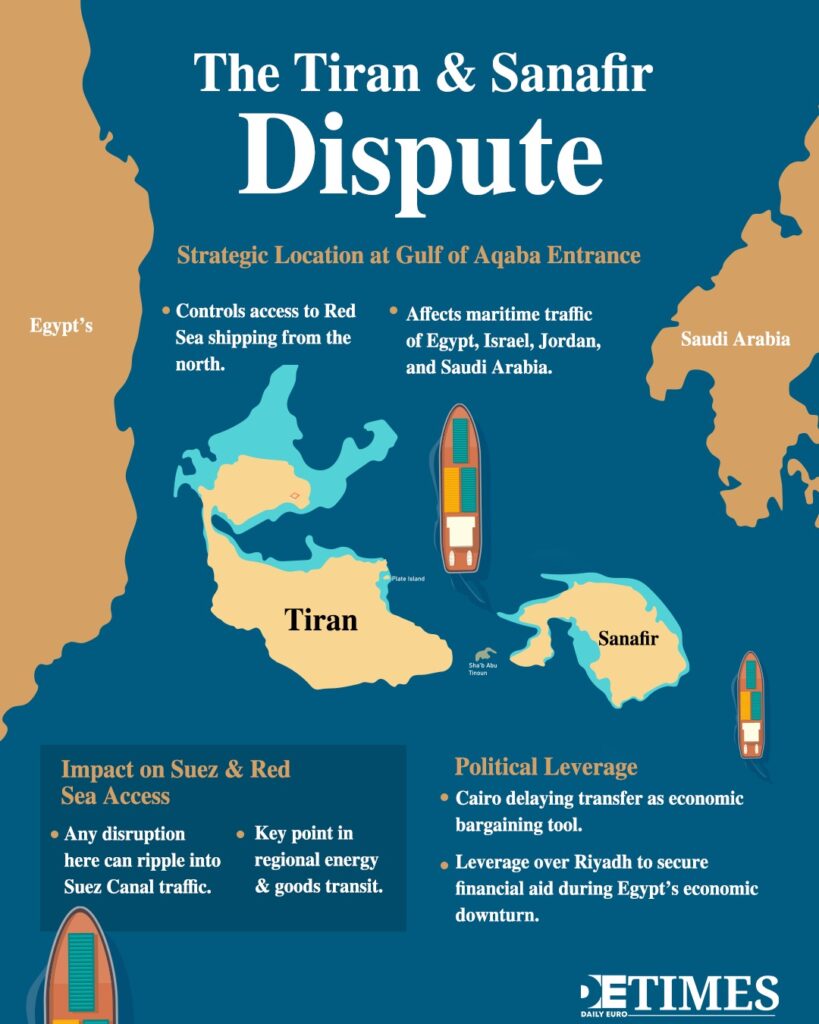Maritime routes remain key for world trade: the Suez Canal connects the Red Sea (Middle East and North Africa) with the Mediterranean (Europe).
This has become especially acute in the context of geopolitical crises, when the stability of these routes becomes critical for the export, import, and transit of energy resources otherwise known as oil.
Sea Corridors Against Crises
The Suez is a vital artery for global trade, handling up to 12% of global cargo traffic, including 30% of container traffic and a significant share of energy transfers.
Yet in 2023-2024, the network was hit by attacks by Houthi rebels on ships in the Red Sea and the Gulf of Aden.
This led to a temporary drop in Suez capacity by 50%. As a result, shipping was rerouted around Africa, via the Cape of Good Hope, which lengthened the route by 8,500 nautical miles and added about 10 days to the journey.
Where does Egypt fit in?
The Suez Canal is the backbone of Egypt’s economy.
In 2024, revenues from the canal fell by almost two-thirds, from $10.25 billion to $3.99 billion, because of the Houthi attacks on maritime shipping following 7 October.
Disputes over Tiran and Sanafir
In parallel, another strategic conflict escalated around the islands of Tiran and Sanafir before the Houthi crisis in the Red Sea.
President Sisi agreed to hand them over to Saudi Arabia back in 2017, yet the transfer has not yet been completed.
We are talking about a key geopolitical hub at the mouth of the Gulf of Aqaba, which controls who can access the Mediterranean or Red sea via the Suez Canal.
These islands were previously under Egyptian control and were used strategically in terms of the security of this route. The delay in negotiations, according to experts, serves as a tool for Cairo to pressure Riyadh in order to obtain economic support during Egypt's financial woes.

Geoeconomics of the Gulf of Aqaba
The Gulf of Aqaba is not just a narrow seaway, but a vital entrance to the Red Sea from the north, through which the sea routes of Egypt, Israel, Jordan and Saudi Arabia pass. Control over Tiran and Sanafir affect the influence of maritime routes and therefore international trade.
For Saudi Arabia, establishing sovereignty over the islands has not only a symbolic meaning, but also a strategic value: expanding control over the Red Sea strengthens its position in regional logistics and security.
This is critical as the kingdom plans to turn the region into a major transit center for goods, tourism, and investment whilst keeping a firm eye on the security of it’s southern border facing Houthi-controlled territories of northern Yemen.
For Egypt, maintaining control or delaying the transfer of the islands is an element of foreign policy play. Cairo shows that even in the face of economic free fall, it is not ready to sacrifice its influence in one of the most important maritime zones.
Why is the Tension Around the Islands Important?
By leaving the dispute unresolved, bilateral relations are strained whilst Riyadh’s mission to become a regional logistics hub for GCC-African-European trade is put on ice. Control of the Red Sea and upper stretches into the Gulf of Aqaba would be a financial and security win for the kingdom, whilst Egypt lacks the financial and military strength to effectively control the Gulf despite the politics of keeping them under Cairo’s control.
It comes as there are reports of Israeli canal plans to excavate another canal, termed the 'Ben Gurion' canal, via Jordan-Israel to the Mediterranean, in turn circumventing Suez if Gaza is annexed in the long-term.
Such a project would raise eyebrows in Riyadh, yet to normalise relations with Israel, but the kingdom could support these measures if alternative maritime routes via Jordan-Israel compound pressure on Egypt into permitting Saudi ownership of Tiran and Sanafir.
Prospects and Scenarios
- Diplomatic settlement: The most likely scenario is a compromise with the preservation of certain guarantees for Egypt on security and navigation issues, with formal recognition of Saudi Arabia’s sovereignty.
- Prolongation of the conflict: If Egypt’s economic situation does not improve, Cairo may continue to use the islands as a tool of pressure, which will prolong the negotiations for years.
- Escalation of tensions: In the event of an escalation of regional conflicts or new threats to shipping, the dispute over the islands could become part of a wider confrontation in the Red Sea.
In the context of the crisis, sea routes have once again become an arena of geopolitics: the Suez Canal and the wider Red Sea have become a strategic theatre.
Clashes of interests, around the islands of Tiran and Sanafir, underscore the importance of this region not only for ships, but the influence and security of states.
The stability of sea routes is the key to global trade. Disputes, such as those with Egypt and Saudi Arabia, require urgent resolution in order to restore trust, minimise risks to global supply chains, and restore regional security in the Red Sea.
Read the Latest Articles on DET!
Confessions and Invisible Tragedies: Why Cheating is More Popular than Death
A New Wave of Bioethics: The Frontiers of Genetic Engineering
Malta Shuts the Door on ‘Golden Passports’: Contribution, Not Direct Investment





